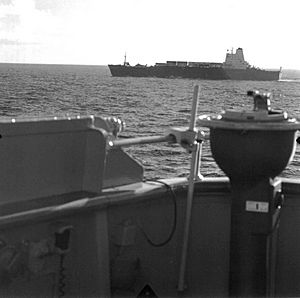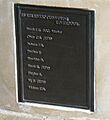SS Atlantic Conveyor facts for kids

Atlantic Conveyor approaching the Falklands. On or about 19 May 1982.
|
|
Quick facts for kids History |
|
|---|---|
| Name | Atlantic Conveyor |
| Operator | Cunard Line |
| Builder | Swan Hunter, Tyne and Wear, United Kingdom |
| Launched | 25 August 1969 |
| Completed | March 1970 |
| Identification | IMO number: 6926036 |
| Fate |
|
| General characteristics | |
| Class and type | Container ship |
| Tonnage | 14,946 GT |
| Length | 695 ft (212 m) |
| Beam | 92 ft (28 m) |
| Speed | 23 knots (43 km/h; 26 mph) |
The Atlantic Conveyor was a British merchant ship. It was registered in Liverpool, England. This ship was called into service during the Falklands War in 1982.
On May 25, 1982, the Atlantic Conveyor was hit by two powerful Exocet missiles. These missiles were fired from Argentine aircraft. Sadly, 12 sailors lost their lives in the attack. The ship caught fire and later sank while being towed on May 28, 1982.
Today, the place where the ship sank is protected. This is because it is the final resting place for those who died. It is protected under the Protection of Military Remains Act 1986.
Contents
What Was the Atlantic Conveyor?
The Atlantic Conveyor was a large ship. It weighed about 14,950 tons. It was a roll-on, roll-off container ship. This means vehicles and containers could be driven directly on and off the ship. It was owned by a company called Cunard.
The ship was one of seven similar container ships. All of them had "Atlantic" in their names. They were part of a group called the Atlantic Container Line consortium.
How Was the Ship Used in the Falklands War?
At the start of the Falklands War, the British government needed ships quickly. They took the Atlantic Conveyor and its sister ship, Atlantic Causeway, for military use. This system was called STUFT (Ships Taken Up From Trade). It meant merchant ships were used by the military.
The Atlantic Conveyor was not fitted with weapons. It also did not have special defense systems. This was because there was not much time. Also, some people thought it was not a "high-value" target. There was also a debate about whether it was legal to arm civilian ships.
The ship's main job was to carry supplies. It supported the British Royal Navy Task Force. This force was sent to take back the Falkland Islands from Argentine forces.
What Did the Atlantic Conveyor Carry?
On April 25, 1982, the Atlantic Conveyor sailed for Ascension Island. It carried six Wessex helicopters. It also had five RAF Chinook HC.1s.
At Ascension Island, it picked up more aircraft. These included eight Fleet Air Arm Sea Harriers. It also took on six RAF Harrier GR.3 jump jets.
One Chinook helicopter left the ship at Ascension. It stayed there to help with operations. After that, the Atlantic Conveyor sailed to the South Atlantic.
When it arrived near the Falklands, all the Harrier jets were moved. They went to the aircraft carriers, HMS Hermes and HMS Invincible. A Lynx helicopter was also parked on the Atlantic Conveyor on May 20, 1982.
The Attack on the Ship
On May 25, 1982, the Atlantic Conveyor was attacked. This was the same day HMS Coventry was also lost. Two Argentine Navy Super Étendard jet fighters fired missiles.
The jets fired two AM39 Air Launched Exocet missiles. Both missiles hit the Atlantic Conveyor. They struck the ship on its left rear side.
Witnesses described the attack as "horrific." Prince Andrew, who was nearby, said debris flew a quarter of a mile away. All the people who survived were taken to HMS Hermes.
Why Did the Ship Sink?
The ship had fuel and ammunition stored below its decks. The missiles' unburnt fuel caused a huge fire. This fire could not be controlled.
After the fire burned out, people boarded the ship. But they could not save anything. The Atlantic Conveyor was being towed by a tugboat called Irishman. It sank in the early morning of May 28, 1982.
Many helicopters were lost in the fire. Six Wessex, three Boeing Chinooks, and one Lynx helicopter were destroyed. Only one Chinook (named 'Bravo November') and one Wessex helicopter were saved. The loss of these helicopters was a big problem. British troops had to walk long distances across the Falklands. This made it harder to recapture Stanley.
Who Died on the Atlantic Conveyor?
Twelve men died when the Atlantic Conveyor sank. This included the ship's captain, Ian North. He was later given a special award, the Distinguished Service Cross (DSC).
The Atlantic Conveyor was the first British merchant ship lost to enemy fire since World War II. A new ship was built to replace it.
The Crew and Memorials
The Atlantic Conveyor had a crew of 33 people from the Merchant Navy. This included officers, petty officers, and other ratings.
Of the 12 people who died, six were from the Merchant Navy. Three were from the Royal Fleet Auxiliary. Three were sailors from the Royal Navy.
The wreck of the ship is a protected site. This is because it is the last resting place for those who died.
There is a memorial for the Atlantic Conveyor in London. It is located at Trinity Gardens, Tower Hill. Also, a bar on a later ship, built in 1984, was named "The North Bar." This was in honor of Captain Ian North.
Images for kids
See also
 In Spanish: SS Atlantic Conveyor para niños
In Spanish: SS Atlantic Conveyor para niños


